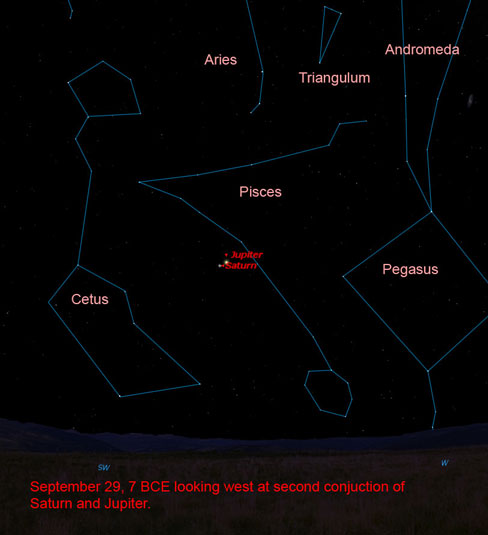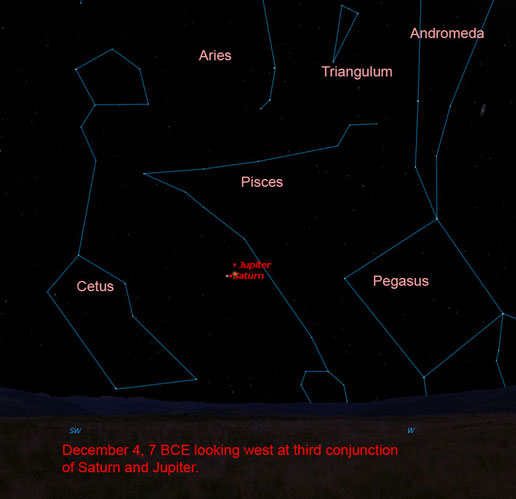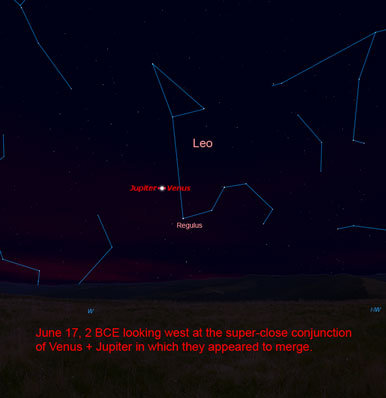

This material is copyrighted!. See my copyright notice for fair use practices. Links to external sites will be displayed in another window. Please support this website.
The Star of Bethlehem is a common topic of questions asked to astronomers, especially around Christmas time because it is a special astronomical phenomenon that occurred around the time of the birth of Jesus the Christ. What was the Star of Bethlehem? The rest of this article will be based on the assumption that there is, in fact, an astronomical event (or events) that was the Star of Bethlehem. There are those who argue (with admittedly good reason) that the assumption is wrong and that we should not try to do historical astronomy with the birth narratives. I will return to this at the end of the article.
The first reference to the Star of Bethlehem is in the New Testament of the Bible in the second chapter of the book called ``Matthew''. Here are the relevant verses from the New Revised Standard Version (NRSV, note that references are annotated as book chapter:verse(s))
Matthew 2:1--2: In the time of King Herod, after Jesus was born in Bethlehem of Judea, wise men from the East came to Jerusalem, asking, "Where is the child who has been born king of the Jews? For we observed his star at its rising, and have come to pay him homage."
Matthew 2:7--10: Then Herod secretly called for the wise men and learned from them the exact time when the star had appeared. Then he sent them to Bethlehem, saying, "Go and search diligently for the child; and when you have found him, bring me word so that I may also go and pay him homage." When they had heard the king, they set out; and there, ahead of them, went the star that they had seen at its rising, until it stopped over the place where the child was. When they saw that the star had stopped, they were overwhelmed with joy.
Matthew 2:12: And having been warned in a dream not to return to Herod, they left for their own country by another road.
Matthew 2:16: When Herod saw that he had been tricked by the wise men, he was infuriated, and he sent and killed all the children in and around Bethlehem who were two years old or under, according to the time that he had learned from the wise men.
Verses 12 & 16 give us some information as to the time of Jesus' birth. Another reference to the time of Jesus' birth is in the second chapter of the book called ``Luke''. Here are the relevant verses from the NRSV:
Luke 2:1--7: In those days a decree went out from Emperor Augustus that all the world should be registered. This was the first registration and was taken while Quirinius was governor of Syria. All went to their own towns to be registered. Joseph also went from the town of Nazareth in Galilee to Judea, to the city of David called Bethlehem, because he was descended from the house and family of David. He went to be registered with Mary, to whom he was engaged and who was expecting a child. While they were there, the time came for her to deliver her child. And she gave birth to her firstborn son and wrapped him in bands of cloth, and laid him in a manger, because there was no place for them in the inn.
I will use the terms ``C.E. = `common era' (= A.D.)'' and ``B.C.E. = `before the common era' (= B.C.)'' when specifying dates.
However, my intention is to provide the historical information that many modern inquirers are asking for. King Herod (aka ``Herod the Great''), Emperor Augustus, and Quirinius were government officials in the Roman Empire so they have historical references with dates attached to them that are used as markers in the history timeline. King Herod is also mentioned in the first chapter of Luke in reference to Jesus' cousin John the Baptizer who was approximately six months older than Jesus. Despite the differences in birth narratives given by the authors of Matthew and Luke, the fact that they do agree on Jesus being born during the reign of King Herod tells us that Jesus was very likely born sometime between 37--4 B.C.E.
Jesus was probably born just a few years before the end of Herod's reign. The ``wise men from the East'' pay homage to the ``child'' Jesus rather than to the ``newborn'' Jesus (contrast that with the Nativity scene of popular society today!). This agrees with Herod's estimate of Jesus' age in his order to kill all the children (other translations narrow that to just the male children) in and around Bethlehem who were two years old or under. The author of Matthew uses the same word to describe Jesus' age when he fled to Egypt with his parents and when he returned after Herod's death---he was a little child when he left and when he returned.
Luke 3:1--2: In the fifteenth year of the reign of Emperor Tiberius, when Pontius Pilate was governor of Judea, and Herod was ruler of Galilee, and his brother Philip ruler of the region of Ituraea and Trachonitis, and Lysanias ruler of Abilene, during the high priesthood of Annas and Caiaphas, the word of God came to John son of Zechariah in the wilderness.
This John is Jesus' cousin, John the Baptizer, and this Herod is Herod the Great's son, Herod Antipas, tetrarch of Galilee and Perea from 4 B.C.E. -- C.E. 39. Tiberius reigned as sole emperor from C.E. 14--37. Philip is Herod Philip, tetrarch of Batanea, Trachonitis, and Auranitis from 4 B.C.E. -- C.E. 33/34 (Luke is the only source claiming Philip ruled Iturea). Caiaphas was high priest C.E. 18--36. Unfortunately, the only Lysanias known to have ruled Abilene from other sources died in 36 B.C.E. Uncertainties in the exact years of Tiberius' reign prevent a firm determination of what year corresponded to the ``fifteenth year''---estimates range from C.E. 26--29. Tiberius was ``co-emperor'' with Augustus from C.E. 12 and became sole emperor upon Augustus' death in C.E. 14. Adding to the uncertainty is the fact that the author of Luke could have used the Julian, Syro-Macedonian, Egyptian, or Jewish calendars to fix his dates. All of the major Roman historians use C.E. 14 as the start of Tiberius' reign and since Luke was likely written for the cultured Greco-Roman person, the author of Luke probably started Tiberius' reign at C.E. 14 and used the Julian or Syro-Macedonian calendar. Therefore, the ``fifteenth year'' is very likely C.E. 28. Jesus began his public ministry shortly after John the Baptizer began his ministry, ie. around C.E. 27--29 (C.E. 28 the most likely start). The author of Luke's rough estimate of Jesus being in his thirties at the start of his ministry makes it likely that Jesus was born within just a few years before 4 B.C.E. One sign of the consensus among scholars of the historical Jesus to this timeline is the holding of the Jesus at 2000 symposium in 1996.
You should notice that I have not used the information in Luke 2:1--2 that tells of a census occurring when Quirinius was governor of Syria. There are a couple of problems with this: 1) a census occurring around B.C.E. 5 is not documented in any other source; and 2) Quirinius became governor of Syria in C.E. 6 and conducted a census of Judea, but not of Galilee, in C.E. 6--7.
You have been very patient to make it through the lengthy argument above in favor of a birthdate of Jesus around 6--4 B.C.E. but there is some debate around King Herod's date of death. If you prefer skipping this defense of King Herod's date of death at 4 B.C.E., go to the next section.
Craig Chester wrote a recent article about the star of Bethlehem that used the work of Ernest Martin to put Herod's death at 1 B.C.E. John P. Meier refutes this later date in his book A Marginal Jew and I use his argument for what follows. Ernest Martin argues for the theory that Herod died in 1 B.C.E. in his article The Nativity and Herod's Death found in the collection of essays Chronos, Kairos, Christos edited by Vardaman and Yamauchi, pp. 85--92. Douglas Johnson (`And They Went Eight Stades Toward Herodeion', same volume pp. 93--99) points out that Martin mistranslates a key text concerning Herod's funeral in Josephus' Jewish Antiquities 17.8.3 section 199. Other contributors to that volume don't support Martin's theory.
King Herod's successors (Herod Antipas, Philip, and Archelaus (=Herod Archelaus) who was ethnarch (a notch above tetrarch) of Judea, Samaria, and Idumea 4 B.C.E.--C.E. 6) all reckoned their reigns began in 5--4 B.C.E. Also, the chronology of datable events happening in the Roman Empire mesh best with Josephus' description of the circumstances of Herod's death if a date of 4 B.C.E. is used instead of the later date 1 B.C.E. Craig Chester points out that the lunar eclipse Martin says occurred when King Herod executed two rabbis would have been hard to detect since it was only 40 percent of total. It was probably possible to predict the lunar eclipse so Josephus could have used that astronomical prediction when he wrote the Jewish Antiquities almost one hundred years after Herod's death.
There were two astronomical events involving conjunctions of planets around the time of Jesus' birth---the triple conjunction of Jupiter and Saturn in Pisces in 7 B.C.E. and the near-conjunction of Mars, Jupiter, and Saturn in Pisces in February 6 B.C.E. (see the illustrations below). A conjunction is when two or more objects appear very close together on the sky. Pisces is associated with the Jewish people in astrology, so when Jupiter and Saturn passed very close to each other three times during the span of several months in 7 B.C.E. it was a notable event. Adding to the significance was that the triple conjunction in Pisces happens about once every 900 years. The first conjunction of the 7 B.C.E triple conjunction occurred in late May when the wise men may have started their journey. The second conjunction occurred in late September when they were visiting King Herod and the third conjunction appeared in the south towards Bethlehem in early December after Herod had sent them on their way. The close grouping of Mars, Jupiter, and Saturn to within 8 degrees of each other in Pisces occurs only once every 800 years. Jupiter was the ``star'' of royalty and luck and Saturn was the star of the Mesopotamian deity who protected Israel. Both of these rare conjunctions could have been predicted by the ``wise men from the East'' and could have been interpreted by them that a great king was to be born in Israel (Herod, king of the Jews at the time and very paranoid about being displaced, was therefore upset at this news). Though Jupiter and Saturn never got close enough together to be confused as a single object, the word ``star'' had a different meaning to the wise men than it does for us today and their definition could have included a planetary conjunction.
| (Select the images to bring up a larger version.) |  |
 |
These wise men (aka ``Magi'') were astrologers (some New Testament translations explicitly call them astrologers) coming from someplace east of Jerusalem (Arabia, Mesopotamia, or elsewhere?). They were probably non-Jewish because they did not know of the prophecy stating that the king of the Jews was to be born in Bethlehem. It probably took the wise men 2-4 months to travel to Jerusalem. Later traditions increased the status of the wise men, making them kings, and to define the number of them to be three, named Caspar, Melchior, and Balthasar.
An alternate conjunction is given by Michael Molnar. He argues for a conjunction of the Moon and Jupiter in the constellation of Aries in April of 6 B.C.E. (two years before my date of 4 B.C.E.). See his web site Revealing the Star of Bethlehem for further details. It is illustrated below, but note that the conjunction would have occurred in daylight. Aaron M Adair in a December 2007 article in Sky & Telescope notes that such a conjunction would have foretold the death of a king. On the other hand a new king can only come to power upon the death of the previous one (adding to Herod's paranoia upon hearing of the news from the Magi).
A planetary conjunction illustrated in the planetarium show "Season of Light" I show at Bakersfield College is a very close pairing of Venus and Jupiter in Leo that occured around 2 B.C.E. in which the planets seemed to merge as seen with the naked eye (no telescopes back then!). This show uses the date of Herod's death in 1 B.C.E. instead of the more widely accepted 4 B.C.E. date. Even though I disagree with this particular planetary conjunction as an explanation for the Star of Bethlehem, the planetarium show does provide a good introduction to the Star of Bethlehem discussion. The show also gives an introduction to the sort of astrological significance the wise men ("Magi") in the Matthew Gospel would have placed on planetary conjunctions.
| (Select the images to bring up a larger version.) |  |
The planetary-conjunction(s) and stationary-Jupiter theories are probably closer to the truth than the nova or comet theories. The planet theories have the least difficulty in explaining the astronomical phenomena that occurred at Jesus' birth sometime in 7--4 B.C.E.
What if the Bethlehem Star was simply made up by the author of Matthew? Great celestial events and the births of notable kings went together. The author of Matthew was writing for a primarily Jewish audience and the author wanted to convince them of the claim of Jesus being the fulfillment of Jewish prophecies and being greater than Moses, their law-giver, and Elijah, their greatest prophet. Saying that the Bethlehem Star was not a real historical event does not detract from the message of Matthew. At worst, it means that all of those Christmas cards with the nativity scenes are not physically/historically correct (but anyone who has carefully read Matthew and Luke already knows that!).
I am going to take a middle path with the final things I say here. Those whose faith is dependent on proving the historical veracity (the "historicity") of Matthew's account of the Bethlehem star are on shaky ground and are missing the real point of the birth story. Those who would dismiss the birth story because it cannot be proved historically accurate are also missing the real point of the story. While both extremes will worship at the altar of literal-factual truth, the vast majority of Christians understand that there is a deeper truth worthy of worship.
last updated: January 7, 2011